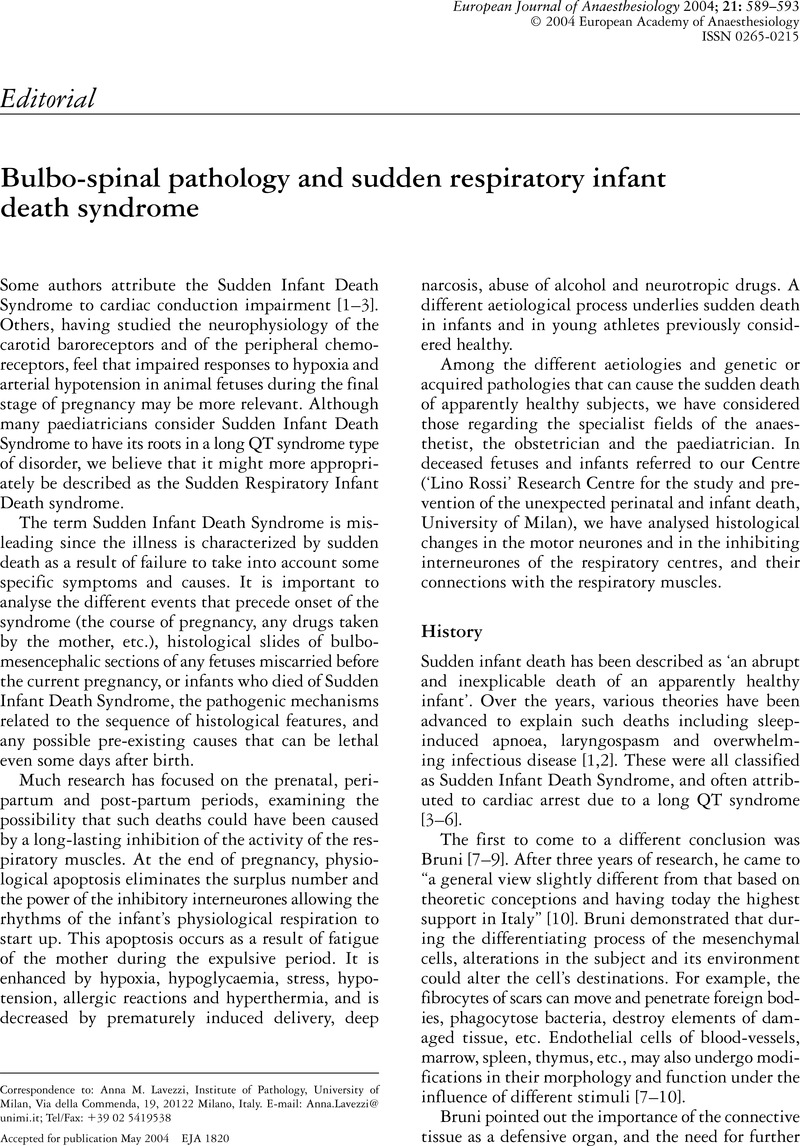Crossref Citations
This article has been cited by the following publications. This list is generated based on data provided by Crossref.
Matturri, Luigi
Ottaviani, Giulia
Benedetti, Giulio
Agosta, Emanuela
and
Lavezzi, Anna Maria
2005.
Unexpected Perinatal Death and Sudden Infant Death Syndrome (SIDS).
American Journal of Forensic Medicine & Pathology,
Vol. 26,
Issue. 2,
p.
155.
Jaster, J Howard
Ottaviani, Giulia
Matturri, Luigi
Lavezzi, Anna Maria
Zamecnik, Josef
and
Smith, Thomas W.
2008.
Sudden Unexpected Death Related to Medullary Brain Lesions.
American Journal of Forensic Medicine & Pathology,
Vol. 29,
Issue. 4,
p.
371.
Gorini, C.
Jameson, H. S.
and
Mendelowitz, D.
2009.
Serotonergic Modulation of the Trigeminocardiac Reflex Neurotransmission to Cardiac Vagal Neurons in the Nucleus Ambiguus.
Journal of Neurophysiology,
Vol. 102,
Issue. 3,
p.
1443.
Gorini, C.
Philbin, K.
Bateman, R.
and
Mendelowitz, D.
2010.
Endogenous Inhibition of the Trigeminally Evoked Neurotransmission to Cardiac Vagal Neurons by Muscarinic Acetylcholine Receptors.
Journal of Neurophysiology,
Vol. 104,
Issue. 4,
p.
1841.
Gorini, C.
Jameson, H.
Woerman, A. L.
Perry, D. C.
and
Mendelowitz, D.
2013.
Prenatal nicotine exposure enhances the trigeminocardiac reflex via serotonin receptor facilitation in brainstem pathways.
Journal of Applied Physiology,
Vol. 115,
Issue. 4,
p.
415.
Ottaviani, Giulia
2014.
Crib Death - Sudden Infant Death Syndrome (SIDS).
p.
181.
Ottaviani, Giulia
2014.
Crib Death - Sudden Infant Death Syndrome (SIDS).
p.
141.
Lavezzi, Anna M.
Corna, Melissa F.
and
Matturri, Luigi
2014.
Disruption of the brain-derived neurotrophic factor (BDNF) immunoreactivity in the human Kölliker-Fuse nucleus in victims of unexplained fetal and infant death.
Frontiers in Human Neuroscience,
Vol. 8,
Issue. ,
Ottaviani, Giulia
2014.
Crib Death - Sudden Infant Death Syndrome (SIDS).
p.
99.
Dyavanapalli, Jhansi
Wang, Xin
and
Mendelowitz, David
2015.
Trigeminocardiac Reflex.
p.
81.
Singh, Gyaninder Pal
Chowdhury, Tumul
Bindu, Barkha
and
Schaller, Bernhard
2016.
Sudden Infant Death Syndrome – Role of Trigeminocardiac Reflex: A Review.
Frontiers in Neurology,
Vol. 7,
Issue. ,
Ottaviani, Giulia
and
Buja, L. Maximilian
2016.
Anatomopathological changes of the cardiac conduction system in sudden cardiac death, particularly in infants: advances over the last 25 years.
Cardiovascular Pathology,
Vol. 25,
Issue. 6,
p.
489.
Ottaviani, Giulia
and
Ramos, Simone G.
2023.
Autopsy for Medical Diagnostics: Finding the Cause of Sudden Unexpected Death through Investigation of the Cardiac Conduction System by Serial Sections.
Diagnostics,
Vol. 13,
Issue. 11,
p.
1919.



